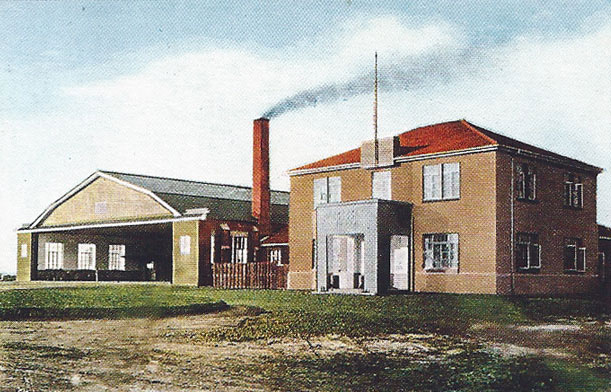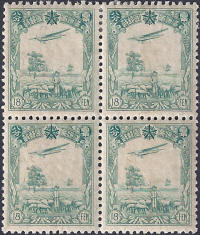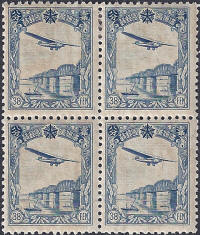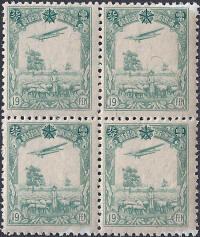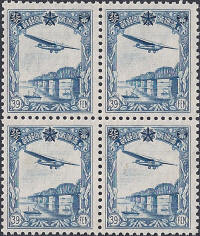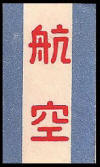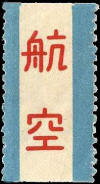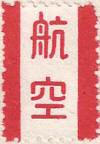 |
||||||||
|
|
1936, 1937 and 1939 Airmail Issues This issue, based upon the Fourth Regular Issue stamps of 1936 provided the first Manchukuo stamps designed specifically for airmail use. Up to this point ordinary stamps could be used for post sent by airmail. The first two values 18f and 38f were issued on Manchukuo from 5th December 1936. In 1937 due to a price increase two new values were issued, 19f and 39f.
Hsinking Airport 1932 The stamps were recess printed on watermarked (see below) "granite" paper in sheets of 100 by the Manchukuo Postal Administration Office, Hsinking. Designs by Mr Hirozo Oya. The stamps are 18.5mm x 22.5mm. Perf 13 x 13˝. Four Designs....
The 18f
and 19f show the an aircraft flying above a shepherd
10,000 copies of the original 1937, 39f
stamp were issued, not nearly enough considering that it could also
be used for general mail purposes. In 1939 the 39f was re-printed using the
same plates ink and paper, the only visible difference being the gum
which is whitish, thin and grainy on the first issue and yellowish,
thick and shiny on the second. Used stamps without gum are
indistinguishable unless they show a readable date in the postmark. It is possible that there were further unrecorded
issues of this stamp making any positive identification of the first
issue doubtful. |
|||||||
| December 1936 Issue | ||||||||
| 10,000 | ||||||||
|
19f issued 16th April 1937 39f issued 14th Sept 1937 re-issued July 1939 |
||||||||
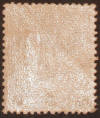 |
This method of identification is not entirely reliable. |
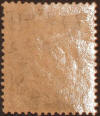 |
||||||
|
Gum 1937 issue whitish, thin and almost matte. |
Gum 1939 Re-issue thick, darker and shiny |
|||||||
| Airmail Rates | Manchukuo/China per 20 grammes* | Japan per 20 grammes | ||||||
|
3rd November 1932 |
Normal Mail + 15f | Normal Mail + 30f | ||||||
| 1st January 1934 | 18f | 38f | ||||||
| 1st April 1937 | 19f | 39f | ||||||
| 1st March 1944 | - | 66f (Disputed) | ||||||
| 1st October 1944 | - | 130f (Disputed) | ||||||
|
*This was based upon standard Japanese practice at this time, Zirkle was wrong in using 10g as the basic weight. Airmail was discontinued within Manchukuo from 1942 due to the war, however certain sources dispute this and believe it continued to be used for express mail where available.
|
||||||||
|
|
||||||||
| M.A.T.C. (Manchurian Air Transport Co.,) Airmail Labels | ||||||||
|
These labels read 航空 Hángkōng (Chinese) or Kōkū (Japanese) the literal meaning being "aviation" and short for Air Mail. The label on the left can be found used in Japan from 1929 if not before. Stocks of this label may have gone to Manchukuo when the M.A.T.C airmail service was launched - see an example on an early cover here. Originally the 18mm wide labels were supplied as a tape which needed to be cut. A later version was supplied in a perforated, tear-off roll (shown right). This form of label is probably specific to Manchukuo. Note; J.A.T.C. (Japanese Air Transport Co) used an almost identical label using a red stripe (see below). The Manchukouan version was based upon this model. |
||||||||
|
|
||||||||
| General Airmail Label | ||||||||
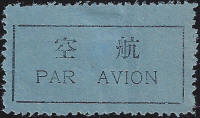 |
||||||||
| Issued by Post Offices, printers unknown. Size 38mm x 17mm, Perf 10˝, No Gum. | ||||||||
|
This blue Airmail (Par Avion) label is
listed in Catalogue of Airmail Labels, by Gunter Mair. He
describes them as Manchukuo Airmail Par Avion Etiquette Labels Ref:
MCH-A-1 and explains that they are supplied in booklets of 20.
I am not sure if these labels are unique to Manchukuo, but as Gunter Mair has made a special study of these items I am willing to take his word for it. |
||||||||
|
Sample Registration Receipt stamped with the
airmail cachet and the
inauguration of Air Mail service
commemorative cancellation, Harbin Post Office. The item measures
190mm x 45mm and is on thin paper similar to newsprint.
|
||||||||
|
|
||||||||

